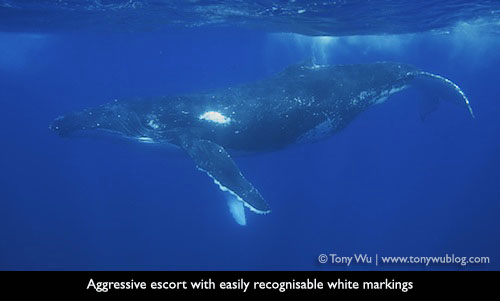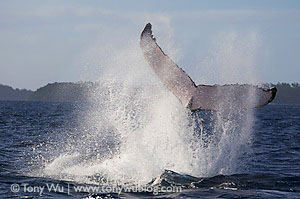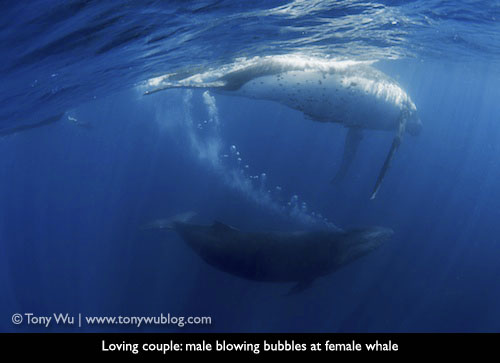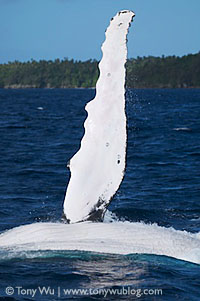Tony Wu blogs from Tonga: Week Two with Humpbacks
Read Tony Wu’s Week One With Humpbacks if you missed the beginning of this feature.

Executive summary for the week: Winds, weather, water and whales all improved, but developing quality encounters with whales is still relatively difficult.
Toward the latter part of the week, some of the activity that moved offshore last week seems to have returned to the waters around the islands, with an increase in calf sightings, heat runs and other interesting behaviour. Whales are singing now (as opposed to the deafening silence last week), and escorts have been associated with all the mothers with calfs that we’ve seen.
Winds of Change
Since I arrived in Tonga a couple of weeks ago, the winds have been strong, holding steady at 20 knots or more on many days. When you’re out on a small boat looking for whales, strong winds, large swells and whitecaps don’t make for a fun time. By the end of a typical day last week and the first half of this one, most people had sore abs, legs and butts from trying to maintain their balance, not to mention sun- and wind-burn to boot.
Fortunately, a high pressure system moved over the Vava’u islands mid-week, bringing wind levels down and making conditions much more pleasant.
Perhaps by coincidence, the whales that moved en masse away from the islands in the early part of last week seemed to start coming back late Wednesday or so (or perhaps it wasn’t coincidence? recall from last week’s summary the anecdotal observation that the whales seem to prefer good weather over bad). In short, the week went something like this:
Sunday: Zilch
Monday: We didn’t go out, but one person in our group did and had a cooperative mother and calf encounter in the late afternoon, but no other encounters to speak of.
Tuesday: Zippo with a side dish of extra-strong winds
Wednesday: Still strong winds, but we found two sets of mother/ calf/ escorts. Both sets never stopped moving, so we didn’t have quality encounters. The escort (easily recognisable by distinct white markings on its dorsal area and sides) of the first set was extremely aggressive, so I kept swimmers out of the water after one look.

The second set was highly mobile, but when I got in to take a look, they were friendly (including the escort). It was late afternoon though, which is traditionally “play time”, so shortly after I made eye contact and established a rapport with them, the baby went on a breaching spree, and the mom and escort had a bit of fun on the surface too. I didn’t get good underwater photos of the mother and calf, so I’ll have a difficult time ID-ing them again.
Thursday: Wind levels dropped significantly. We followed a heat run for most of the day. It started with four whales, built to five, then split to a pair and a triple, with the triple forking out in different directions almost immediately thereafter, and the pair being joined by first one then another whale…to continue the heat run. My guess is that the pair was a male and female, and the trio that split off and immediately parted ways were the “rejects” who went off in search of other potential mates. There was a lot of surface activity, and we dropped in a few times to take a closer look when the whales were mellow.
Friday: With only a couple of days to go until full moon, the conditions were really nice. Everyone had whales. We started the morning with a heat run of two, then three, then four…among which there were two whales with substantially white pectoral fins (something I’ve kept an eye out for over the past several seasons). Of the two, one had a mostly black body (more characteristic of northern hemisphere humpbacks), while the other was unusually white. I thought I recognised the mostly black one from previous years, but on closer inspection of previous photos…no match.

Two particularly interesting things I saw on Friday included a whale pee-ing while executing a tail slap (it was one of the whales in the heat run). The froth generated by the whale’s tail slap turned a brilliant yellow hue, which served as significant disincentive for getting into the water. You wouldn’t believe the volume of pee an adult whale generates. All of us gawked in fascination; none of us thought to take a photo. Doh!
Later in the afternoon, we had a singer directly under the boat (too deep to see though), and we came across a whale resting nearly motionless at the surface. Our guess that it might be a pregnant female proved correct when we got in to take a look. In a word, she was humonstrous…the biggest, fattest whale I’ve ever seen.

It’s almost full moon, so there’s no doubt she’ll give birth soon (she’s probably done so by the time I post this). We floated next to her for a while, during which time another companion whale swam below and around us. At one point, the pair dived suddenly, shooting straight down into the murky depths (we were in an area of low visibility with piss-poor light). Moments later, the pregnant mom flew out of the water and did a full-body breach, perhaps 20 metres away from us. The sound and reverberation of her landing was deafening. She did a couple more aerial stunts for good measure, then went back to resting mode.
We also came across two mother/ calf/ escort groups during the day, neither of which we were able to get in with. The second one may have been the one with the aggressive escort from Wednesday. Another boat found a third group, so there are at least three babies around now.
Finally, one of our boats saw whales mating while swimming at high speed underneath them. The whales were flush against one another, belly-to-belly. Unfortunately, the whales (and hence the boat) were moving so quickly that it was impossible to get into the water or even hold a camera in the water.
On Nuance

Scientists generally admonish upcoming researchers and people in general from attributing human characteristics, traits, emotions, etc. to other species. This is a concept that’s pretty well drilled into your head if you’re a budding animal science guy or gal.
In general, I agree with this guiding principle, but over the years as I’ve spent thousands of hours with marine animals of all description, the more I find myself questioning the wisdom of this dogma.
At issue for me is how we interpret (or more accurately, try to interpret) animal behaviour. In large part because we try not to “humanise” animals, we tend, I believe, to oversimplify our conclusions and opinions. We tend to think along the lines of something like: “When an animals does A, then it’s trying to accomplish B, because of C.” Quite often, this type of thought process seems logical and does contribute to our understanding of the animal in question.
The problem is that this type of “If A, then B.” thinking seems too digital, too black-and-white, too restrictive. In other words, it tends to gloss over the possibility for nuance…for the possibility of “If A, then B, C, or D, sometimes all, sometimes none, sometimes some…depending on the context, ambient conditions, and other apparently unrelated stuff.” type of situation.
Before you conclude that I’ve gone crystal-worshipping flaky, consider the following: When a person slaps another person, it can mean anything from “You disgust me.” to “I love you.” to anything in between and sometimes both at the same time. Clear as mud, right?
If you were an alien studying humans, how would you characterise the meaning of a slap such that you were correct 99% of the time? A simple “If A, then B.” assessment doesn’t always work.
Consider then humpback whales. The accepted wisdom about why whales (and other cetaceans) blow bubbles is that it’s a sign of aggression. In many cases (such as heat runs), this is definitely true. Males blow bubbles at each other in conjunction with ramming one another, tail slapping each other, charging at other whales, grunting, etc….all as signs of aggression while in pursuit of a fetching fertile female.
However, when an affectionate male/ female pair blow bubbles at one another while executing gentle, ballet-esque moves and caressing one another, it can’t possibly be a sign of aggression, can it? When a mom or baby blows bubbles at the other, it might be a sign of “I’m pissed off with you.”, but in the times I’ve witnessed this behaviour, it seems more like “I love you.”
This week, we saw whales in heat runs blowing bubbles at each other…not much doubt about the aggressive intent of those bubbles.

But last week, a whale blew bubbles at me. Most people (me included) would normally characterise this as aggressive behaviour. In the context of what was happening though (she was blowing bubbles at her mate, and vice versa, as if caressing one another in a jacuzzi-style bubble bath), I was confused. There were no threatening gestures, and we had been in the water together for at least 30 minutes. She approached, glided by and sent some bubbles my way, continued her glide by, and blew more bubbles at her mate.
Since this took place, I’ve re-played the scene over and over in my head, noting the eye contact, the events leading up to the bubbles, and the extensive interaction we had after the bubbles…trying to make sense of what happened. I can’t think of a single thing that remotely suggested aggression, so the only conclusion I can draw is that it was not an act of aggression, but something else…perhaps even a sign of affection, or at least acceptance. In the context of the lovey-dovey male-female bonding that was going on, I think it’s reasonable to assume it was a friendly gesture. (But of course, I could be entirely mistaken and it could’ve meant something like: “Stay away from my man.”)

My point is that nuance characterises much animal behaviour, including ours. Not attributing human characteristics to animals is generally a good thing, but not if comes at the expense of considering all possibilities. I think the single biggest mistake that people make in trying to understand animals (and arguably one another) is discounting nuance and thereby oversimplifying.
Logistical Challenges

I’ve received a lot of emails from people who are either going to visit Tonga, or are considering visiting Tonga. For anyone who’s contemplating a visit, here’s a brief word of advice: Have a Plan B, a Plan B for Plan B, and a Plan B to back up the second Plan B.
Logistics in Tonga can be a nightmare (as is the case in many otherwise idyllic places). On Monday, these are a fraction of the issues I dealt with: Internet down. Mobile phone network nonfunctional. Normal phones iffy at best. Hotel bookings for my friends all screwed up. Four of my friends booted from domestic flight just minutes after I received written confirmation that they had confirmed seats. Travel agent avoiding all phone calls. Arranging airport pick-up for friends, while frantically calling all over the country to sort out flight chaos. One of the boats not ready in time.
Each of those issues, plus many more, took hours to resolve (and then only temporarily), meaning that I spent the better part of the week dealing with logistical problems. The fact that I was out at sea during normal business hours only exacerbated the situation.
So the bottom line is: trust, but verify, re-verify, then double-check, and have a contingency plan for everything.
Camera and Photo Questions
I’ve received a flood of questions about which cameras, which lenses, which camera settings, etc. to use for whales. I’m trying to respond to most, but when I run short of time (i.e., every day), I can only answer the queries that are well thought out.
After a long day at sea and firefighting logistical problems, getting an email asking: “Tell me what lenses to use, which cameras and the exact settings you use, as well as which operator and which boat to use, and what areas and what times of day to go out.”…I probably won’t respond. Seriously, Google it.
Fortunately, there are more informed questions than blanket tell-me-everything-because-I’m-too-lazy-to-think questions.
To amalgamate the answers: Cameras - Use whatever you have or like. I use Canon, but I’m fine with Nikon. Don’t obsess over camera brand. Lenses underwater - Wide angle. Prime or zoom, either is fine. I use fisheye to about 40mm range. Lenses above water - Fast zooms in the 100mm to 400mm range, with image stabilisation if possible. Prime lenses are great, but you’ll be held slave to the perspective you happen to have. Whales unfortunately aren’t considerate enough to perform within your optimal pre-set field-of-view.
Photos - The most important consideration is understanding whale behaviour and making the whales comfortable. If you have your camera set perfectly for the conditions but spook the whales, you get photos with spooked whales (which comes through crystal clear). You also need to be able to control yourself with grace in the water. Whales (and most marine animals) don’t respond well to loud entries into the water, or frantic splashing and flailing limbs. Float instead of swim. Observe instead of rapid-fire clicking your shutter. Don’t charge the whales. You’ll get crappy pictures, and worse, you’ll spook the whales so they may not interact with anyone else either.
Sharing Information

Colin Gans, who resides in Auckland, sent me a link with nice photos of humpbacks he took at the beginning of August in Niue (he’s a frequent visitor there), which isn’t far from Tonga. He sent me the images to ask whether I’d seen these whales in Tonga, and if not, to keep an eye out for them.
As it turns out, I haven’t seen these particular whales (easily recognisable by their body colouration), and neither has anyone else I’ve shown the pictures to.
But…the important and really cool thing is that we’re sharing information, which is what the net is for, and the reason that I invest time writing these summaries.
Colin has given me the contact information for a couple of other people in this region who are interested in humpbacks, so hopefully, we’ll be able to set up a network of people who are able to gather and compare photos on a regular basis. Who knows? Maybe we’ll find a match somewhere along the way.
If anyone out there recognises any whales I post here or to Flickr, please let me know.
Thanks Colin!
Friends

Finally, what makes this trip special each year (besides the whales of course) is all the friends I get to see…Tongans, expats living here, annual visitors like me, and the people who travel here to join us. This week we had 13 friends here from Asia, all of whom saw whales in and out of the water, many of whom have already committed to visit Tonga again next year.
Among them, we had a young couple spending their honeymoon here with us (the second time this has happened), which placed particular pressure on us. Things turned out really well though, and they had the time of the lives. Actually, they went on their honeymoon before their wedding (young people are so mixed up these days), and we’re now invited to their wedding. They may yet regret extending the invitation.
Humpback whales are more than just beautiful animals. Their presence here brings people together from all corners of the world. Whales or not, we always have a great time.